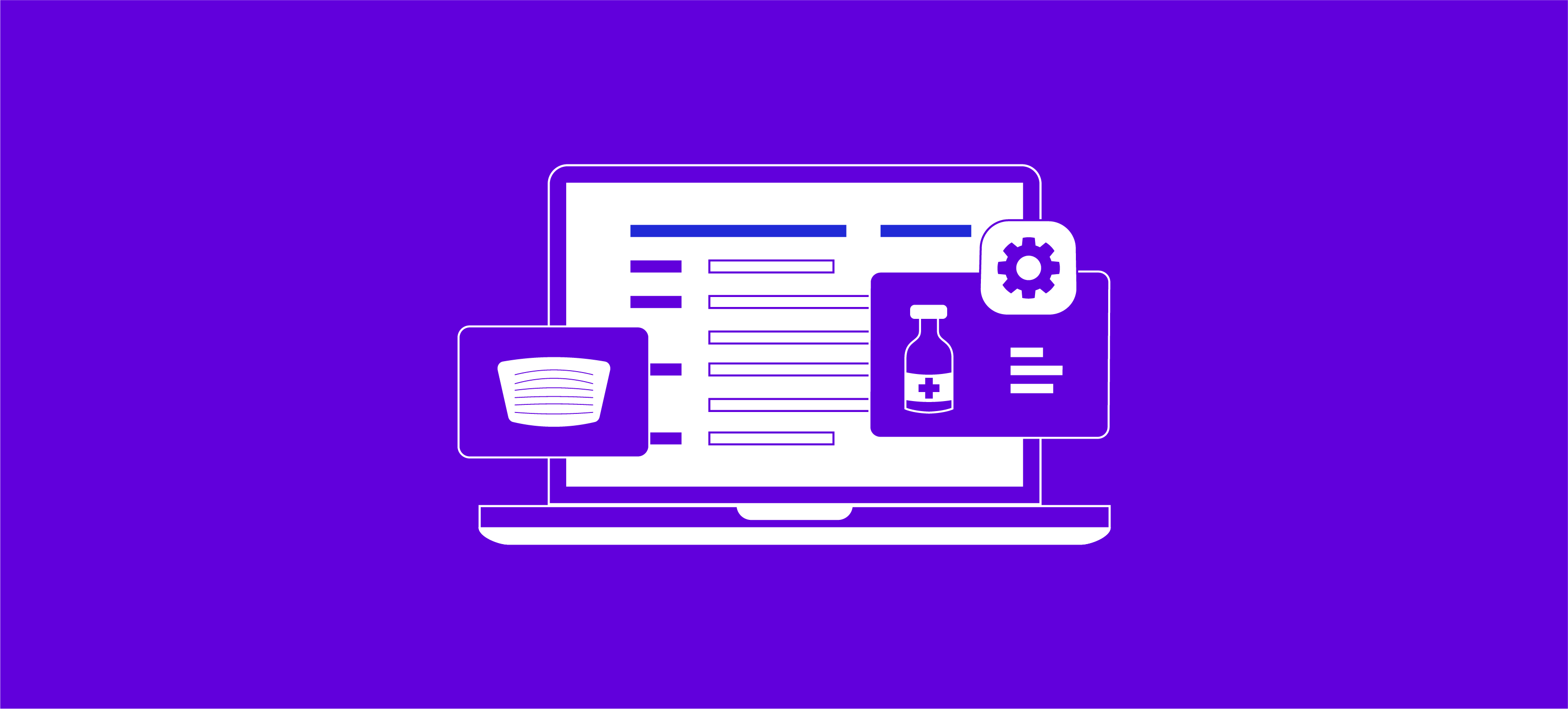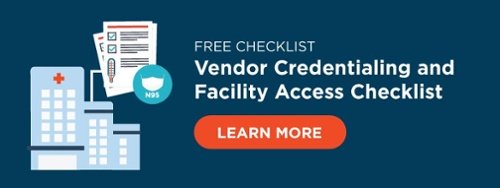Managing essential vendors in healthcare: COVID-19 and preparing for crises

On a typical day, managing vendors and visitors coming in and out of your healthcare facility or health system is a big job. The negative ramifications of improper screening and verification ripple through patient safety, quality, compliance, and efficiency. In the midst of disasters or crises like the unprecedented COVID-19 pandemic, organizations are adapting quickly, managing new or different populations entering facilities, many even going as far as instituting a total lockdown.
While you can never fully prepare for the unknown, start by ensuring you have readily accessible documentation of essential vendors. What’s considered indispensable will vary by organization and will be defined by the situation at hand. Nevertheless, your “essential” list can serve as a starting point that shaves crucial time during emergencies.
Categorize essential workers & determine vendor participation
Chances are, your facility is part of a larger healthcare system. Start local and then collaborate with colleagues system-wide to identify affected sites. Take stock of individuals who work in or provide services to hospital owned or affiliated freestanding and outpatient facilities including:
- Ambulatory facilities
- Non-hospital surgical sites
- Blood banks
- Retail or other standalone clinics such as urgent care
- Mental or behavioral health centers, residential or outpatient
- Outpatient rehabilitation sites
- Home healthcare divisions and hospices
- Nursing facilities and assisted living residences
- Rural health clinics and federally qualified health centers
Starting with healthcare workers, determine by title or role who is essential using the following sample categories, adding others unique to your organization. Mark whether each category includes vendors currently, and whether new or pending circumstances would require vendor credentialing.
Medical/clinical and care service professionals
This category includes physicians, dentists, psychologists, PAs, CRNAs, advanced practice professionals, non-CRNA nurses and assistants, infection control and quality assurance personnel, pharmacists, physical and occupational therapists and assistants, social workers, speech pathologists, audiologists, diagnostic and therapeutic technicians and technologists, providers of mental and behavioral healthcare, nutritionists, respiratory therapists, personal care attendants, home health aides, and home care workers. The category also includes medical students, researchers, and consultants who closely work with the regular medical staff in your organization.
⬜ Category currently includes vendors
⬜ Would require vendor credentialing depending on crisis
Hospital administrative and lab personnel
This category covers examples such as administrative and medical staff services leadership professionals, admitting and discharge personnel, engineering staff, epidemiology staff, plasma and blood donation operations teams, services workers (food, laundry, housekeeping, sanitation/janitorial), medical records staff, IT and cyber security, and the like.
⬜ Category currently includes vendors
⬜ Would require vendor credentialing depending on crisis
Non-medical/clinical staff in residential facilities
These workers cater to the needs of residential elderly, children, and those with developmental, intellectual, physical, or cognitive disabilities.
⬜ Category currently includes vendors
⬜ Would require vendor credentialing depending on crisis
Supply chain participants
The individuals in this category encompass logistics and operations necessary to ensure the facilitation of the supply chain, which includes medical devices, equipment, personal protective equipment (PPE), medical gases, pharmaceuticals, blood and blood plasma products, vaccines, testing materials, laboratory supplies, bedding and gowns, cleaning supplies (disinfection, sterilization), and paper goods.
⬜ Category currently includes vendors
⬜ Would require vendor credentialing depending on crisis
All other staff and associated service professionals
The range of individuals relevant to your facility's operations is unique but could include examples including:
- Public health/community health workers and communication professionals
- Blood and plasma donors
- Health plan and billing professionals
- Epidemiological surveillance and analysis professionals
- Non-clinical COVID-19 response workers
⬜ Category currently includes vendors
⬜ Would require vendor credentialing depending on crisis
Visitors
COVID-19 has created circumstances wherein some facilities have locked down, preventing visitors altogether. In areas not as hard-hit, floors with sicker patients have been closed to visitors. Determine and document all areas of your facility that may house patients more susceptible during a pandemic or other outbreak.
⬜ We have a visitor management system in place
⬜ Our system includes categorization by department to allow departmental lockdown
Four tips to effectively manage essential vendors
We monitor vendors and visitors to protect healthcare organizations and all lives within them against safety and security risks. But it’s also critical to establish a running record in the event it needs to be referenced in the future. Modern vendor and visitor management tools not only enable the management of multiple access levels—patient care, administrative, all access, visitor—but also allow for easier knowledge transfer. Today’s larger, more complex systems mean that multiple users need access to your digital records for better decision making.
Once you have identified your essential vendors, use these tips for ongoing management:
Use a vendor credentialing software system
It’s virtually impossible to effectively manage all vendor credentialing requirements using a manual system. Stopping unauthorized access at the entry point is just the start. The right technology also captures and stores critical information on your vendors like their associated company, confirmation that they have passed a background check, and that they’ve agreed to comply with all of your facility’s policies and credentialing requirements; all accessible in reports and dashboards..
Technology is especially useful when it comes to reporting and monitoring. The most effective systems provide real-time visibility into the vendors who access a facility. Another benefit of using onsite equipment for vendor check-in and day-pass printing is that it dramatically decreases facility administration workload while increasing vendor compliance to policies.
Treat your essential vendors list as a living document
Keep in mind that your active list of essential vendors will not remain static. Once the emergency or crisis subsides, take the time to review and update your essentials list. Involve the appropriate staff and vendors to understand where you may have been off-target by excluding someone later deemed indispensable. Likewise, restrict access in the future where necessary, based on your experiences and onsite staff input.
Double-check essential vendors’ credentialing requirements
Effective credentialing tracks multiple moving parts—from background checks and exclusion screenings, to vaccinations, updated training, and facility-specific policy compliance. Crises such as the COVID-19 pandemic can expose weaknesses in systems. It’s important to ensure credentialing does not take a back seat during chaotic circumstances or when compliance staff must work remotely.
Compliance is a two-way street, but consider that there is no standard and your vendors face different requirements at multiple facilities. Make it easy for them to submit and maintain updates to enable access.
Communicate early and often with vendors
Your official policy for vendors helps them understand your facility’s requirements and perspective under “normal” circumstances, so that they can do their part to ensure their own compliance. Likewise, when decisions are made during crises to restrict or bar vendors, you must communicate updates. Educate your entire vendor population to let them know who is deemed essential, why, and for what time period. If regular updates will be posted or distributed, give them a time frame, even if it’s an estimate.
Vendors will appreciate your efforts to make their business with your facility as seamless as possible, and your staff can focus on the crisis at hand. Consider distributing messages via your software if it allows, and also posting vendor updates on your website.
The responsibilities of compliance professionals responsible for vendor management are more critical than ever during difficult times. Use all of the tools at your disposal to demonstrate your facility’s readiness to ensure safety, quality, compliance, and efficiency in response to COVID-19.
Learn more about vendor management today.

